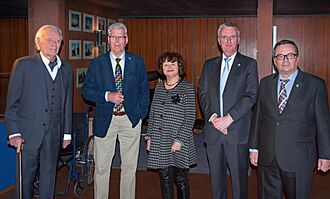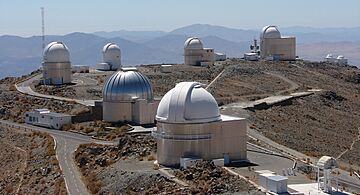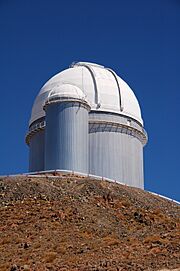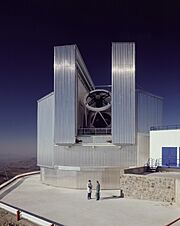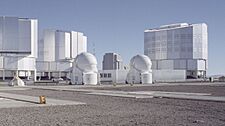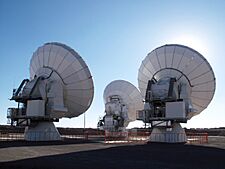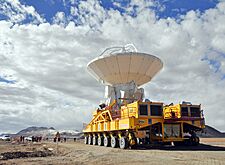European Southern Observatory facts for kids
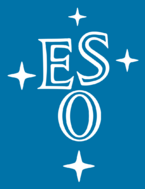 
(L–R): ESO logo; Map of member states
|
|
| Abbreviation | ESO |
|---|---|
| Formation | 1962 |
| Type | Intergovernmental organisation |
| Purpose | Astronomy |
| Headquarters | Garching, Germany |
|
Membership
|
16 |
|
Official language
|
English, French, German
|
|
Director General
|
Xavier Barcons |
The European Southern Observatory (ESO) is a special group of 16 countries working together. Their main goal is to study space using powerful telescopes on the ground. ESO was started in 1962. Since then, it has given scientists amazing tools to explore the southern sky. Over 750 people work for ESO. Its main observatories are located in northern Chile.
ESO has built and runs some of the biggest and most advanced telescopes in the world. These include the 3.6-meter New Technology Telescope (NTT). The NTT was a pioneer in using "active optics" to keep images clear. Another famous telescope is the Very Large Telescope (VLT). It is made of four huge 8.2-meter telescopes and four smaller ones. They can work together or separately. The Atacama Large Millimeter Array (ALMA) looks at the universe using special light waves. It is the biggest ground-based astronomy project ever built. ALMA was finished in March 2013. Many countries from Europe, North America, East Asia, and Chile worked together on it.
The Extremely Large Telescope (ELT) is currently being built. It will have a giant mirror, almost 40 meters wide. When it starts working, it will be the world's largest optical telescope. The ELT will help scientists study planets around other stars. It will also look at the first objects in the universe. Scientists hope to learn more about supermassive black holes. It will also help understand dark matter and dark energy. These mysterious things make up most of the universe.
ESO's telescopes have made many important discoveries. They have also created several star maps. For example, they found the farthest gamma-ray burst ever seen. They also found evidence of a black hole at the center of our own Milky Way galaxy. In 2004, the VLT took the first picture of a planet outside our solar system. This planet, called 2M1207b, orbits a "brown dwarf" star. The HARPS instrument on the ESO 3.6-meter telescope found many other planets. One of these was Gliese 581c, one of the smallest planets found outside our Solar System.
Contents
History of ESO
The idea for a big European observatory started in 1953. Two astronomers, Walter Baade and Jan Oort, thought it would be a good idea. They wanted to build a large telescope that many European countries could use together. At that time, all the big telescopes were in the northern part of the world. But some parts of space, like the center of the Milky Way, can only be seen from the southern part of the world. So, they decided to build the new observatory in the southern hemisphere.
| Director General | In office |
|---|---|
| Otto Heckmann | 1962–1969 |
| Adriaan Blaauw | 1970–1974 |
| Lodewijk Woltjer | 1975–1987 |
| Harry van der Laan | 1988–1992 |
| Riccardo Giacconi | 1993–1999 |
| Catherine Cesarsky | 1999–2007 |
| Tim de Zeeuw | 2007–2017 |
| Xavier Barcons | 2017–present |
| Source: www.eso.org, about ESO | |
At first, they thought about building the telescopes in South Africa. But tests showed that the Andes mountains in Chile were a better spot. So, on October 5, 1962, five countries signed an agreement to create ESO. These countries were Belgium, Germany, France, the Netherlands, and Sweden. Otto Heckmann became the first director of ESO. On November 15, 1963, Chile was officially chosen as the home for ESO's observatory.
In 1966, the first ESO telescope started working at the La Silla site in Chile. ESO also worked closely with CERN, another big European research group. In 1980, ESO's main offices moved to Garching, near Munich, in Germany. In 2015, a scientist named Guillem Anglada-Escudé confirmed the existence of Proxima Centauri b using ESO telescopes.
ESO Member Countries
| Country | Joined |
|---|---|
| 1962 | |
| 1962 | |
| 1962 | |
| 1964 | |
| 1964 | |
| 1967 | |
| 1982 | |
| 1982 | |
| January 1, 2001 | |
| July 8, 2002 | |
| July 1, 2004 | |
| July 1, 2006 | |
| January 1, 2007 | |
| July 1, 2008 | |
| October 28, 2014 | |
| September 28, 2018 |
ESO's Observatories in Chile
Even though ESO's main office is in Germany, its powerful telescopes are in northern Chile. This area is one of the best places in the southern hemisphere to observe the sky. ESO runs three main observatories there:
- La Silla, home to the New Technology Telescope (NTT).
- Paranal, where the Very Large Telescope (VLT) is located.
- Llano de Chajnantor, home to ALMA, the Atacama Large Millimeter/submillimeter Array.
The Extremely Large Telescope (ELT) is also being built in Chile. It will be a huge telescope, about 40 meters wide. Construction started in June 2014. The ELT will be located at a fourth site called Cerro Armazones.
Every year, scientists ask to use ESO telescopes about 2,000 times. This is much more than the time available. The discoveries made with these telescopes are published in many science papers. In 2017, over 1,000 papers used data from ESO.
ESO telescopes collect a lot of data very quickly. This data is saved in a special archive at ESO headquarters. The archive holds more than 1.5 million images. This is about 65 terabytes of data, which is a huge amount!
| Name | Short | Size | Type | Location | Year |
|---|---|---|---|---|---|
| ESO 3.6 m telescope – hosting HARPS | ESO 3.6m | 3.57 m | optical and infrared | La Silla | 1977 |
| MPG/ESO 2.2 m telescope | MPG | 2.20 m | optical and infrared | La Silla | 1984 |
| New Technology Telescope | NTT | 3.58 m | optical and infrared | La Silla | 1989 |
| Very Large Telescope | VLT | 4 × 8.2 m 4 × 1.8 m |
optical to mid-infrared, array | Paranal | 1998 |
| Visible and Infrared Survey Telescope for Astronomy | VISTA | 4.1 m | near-infrared, survey | Paranal | 2009 |
| VLT Survey Telescope | VST | 2.6 m | optical, survey | Paranal | 2011 |
| Atacama Large Millimeter/submillimeter Array | ALMA | 50 × 12 m 12 × 7 m 4 × 12 m |
millimetre-/submillimetre-wavelength interferometer array |
Chajnantor | 2011 |
| Extremely Large Telescope | ELT | 39.3 m | optical to mid-infrared | Cerro Armazones | End of this decade |
| ALMA is a partnership among Europe, the United States, Canada, East Asia and the Republic of Chile. · Additional ESO research facilities are located in Santiago, Chile and include a library, computing resources and programmes for visiting scientists. · ESO also maintains close ties with other observatories and universities throughout the country. · Source: ESO – Telescopes and Instrumentation |
|||||
La Silla Observatory
La Silla is ESO's first observatory. It is located in the southern Atacama Desert, about 600 kilometers north of Santiago de Chile. The observatory sits high up, at 2,400 meters above sea level. Like other observatories in this area, La Silla is far from city lights. This means it has one of the darkest night skies on Earth. At La Silla, ESO operates three main telescopes. These are the 3.6-meter telescope, the New Technology Telescope (NTT), and the 2.2-meter Max-Planck-ESO Telescope.
La Silla also hosts telescopes from other countries. For example, there is a 1.2-meter Swiss telescope and a 1.5-meter Danish telescope. About 300 science papers each year use data from La Silla. Discoveries made here include finding planets around the Gliese 581 planetary system. One of these planets was the first rocky planet found in a "habitable zone" outside our solar system. La Silla telescopes also helped link gamma-ray bursts to exploding massive stars. These bursts are the most powerful explosions in the universe since the Big Bang.
ESO 3.6-meter Telescope
The ESO 3.6-meter telescope started working in 1977. It has been updated over the years. It now hosts the HARPS instrument. HARPS is used to search for planets outside our solar system. It also studies how stars vibrate, which is called asteroseismology. This telescope is very good at measuring how fast stars move towards or away from us.
New Technology Telescope (NTT)
The New Technology Telescope (NTT) is a 3.58-meter telescope. It was opened in 1989. It was the first telescope in the world with a main mirror controlled by a computer. The mirror's shape can be changed during observations. This helps keep the image quality perfect. This technology, called active optics, was developed by ESO. It is now used in all major telescopes, including the VLT and the future ELT.
The building that holds the NTT is also special. It is designed to let air flow smoothly around the mirror. This reduces air movement that can blur images.
MPG/ESO 2.2-meter Telescope
The 2.2-meter telescope has been at La Silla since 1984. It is on loan to ESO from the Max Planck Society in Germany. ESO and the Max Planck Society share the time on this telescope. ESO is in charge of running and maintaining it.
This telescope has a special camera called WFI. It can take very wide pictures of space. It has taken many amazing images of stars and galaxies. Another instrument, GROND, looks for the afterglow of gamma-ray bursts. These are the most powerful explosions in the universe.
Other Telescopes at La Silla
La Silla also has other telescopes not run by ESO. These include the Swiss Euler Telescope and the Danish National Telescope.
- The Euler Telescope is a 1.2-meter telescope. It is used to find large planets outside our solar system. It also studies variable stars and gamma-ray bursts.
- The 1.54-meter Danish National Telescope has been at La Silla since 1979.
- The Rapid Eye Mount telescope (REM) is a small, fast telescope. It started working in 2002. Its main job is to quickly observe the afterglow of gamma-ray bursts.
- The Belgian TRAPPIST telescope is 0.60 meters wide. It studies comets and planets outside our solar system. It helped show that the dwarf planet Eris might be smaller than Pluto.
- The Quick-action telescope for transient objects, TAROT, is a very fast robotic telescope. It can observe gamma-ray bursts right from the start.
Paranal Observatory
The Paranal Observatory is located on top of Cerro Paranal. This mountain is in the Atacama Desert in northern Chile. Cerro Paranal is 2,635 meters high. It is about 120 kilometers south of Antofagasta.
The observatory has seven large telescopes. They observe in visible and infrared light. These include the four 8.2-meter telescopes of the Very Large Telescope. There is also the 2.6-meter VLT Survey Telescope (VST). The 4.1-meter Visible and Infrared Survey Telescope for Astronomy (VISTA) is also there. Four smaller 1.8-meter telescopes work together for special observations. In March 2008, Paranal was used as a filming location for the James Bond movie Quantum of Solace.
Very Large Telescope (VLT)
The VLT is the main facility at Paranal. It has four almost identical 8.2-meter telescopes. Each telescope has two or three instruments. These large telescopes can also work together as one giant interferometer. This is called the ESO Very Large Telescope Interferometer (VLTI). The VLTI lets astronomers see details up to 25 times finer than with just one telescope. It can see things as small as car headlights on the Moon.
The first VLT telescope started working in May 1998. All four telescopes were fully operational by 2000. Four smaller 1.8-meter telescopes were added between 2004 and 2007. They are used when the main telescopes are busy with other projects.
Data from the VLT leads to many scientific papers. In 2017, over 600 papers used VLT data. VLT discoveries include taking a picture of a planet outside our solar system. It also tracked stars moving around the supermassive black hole in the center of the Milky Way.
The four VLT telescopes have special names from the Mapuche language. They are Antu (sun), Kueyen (moon), Melipal (Southern Cross), and Yepun (Evening Star).
Survey Telescopes at Paranal
The Visible and Infrared Survey Telescope for Astronomy (VISTA) is next to the VLT. VISTA's main mirror is 4.1 meters wide. It is a very curved mirror for its size. Building and polishing it was a big challenge. VISTA was developed by 18 universities in the United Kingdom. It started working in 2009.
The VLT Survey Telescope (VST) is a 2.6-meter telescope. It has a 268-megapixel camera. This camera can see an area four times larger than the full moon. The VST started working in 2011. It works with VISTA to survey the sky using visible light.
Both VISTA and VST collect a lot of data. A single picture from VISTA has 67 megapixels. Images from VST have 268 megapixels. These two telescopes collect more data every night than all the other VLT instruments combined. They produce over 100 terabytes of data each year.
Llano de Chajnantor Observatory
The Llano de Chajnantor is a high plateau in the Atacama Desert. It is 5,100 meters high. This area is very dry. This makes it a great place for submillimetre astronomy. Water vapor in the air can block these light waves. So, a dry place is needed. The telescopes here include:
- Atacama Pathfinder Experiment (APEX)
- Atacama Large Millimeter Array (ALMA)
ALMA is a telescope designed for millimetre and submillimetre astronomy. This type of astronomy explores the "cold universe." It looks at light from huge, cold clouds in space. These clouds are where new stars are born. In visible light, these areas are often dark because of dust. But they shine brightly in millimetre and submillimetre light. This light also helps study the earliest galaxies in the universe.
Atacama Pathfinder Experiment (APEX)
ESO hosts the Atacama Pathfinder Experiment, APEX. It operates it for the Max Planck Institute for Radio Astronomy. APEX is a 12-meter telescope. It works with millimetre and submillimetre light waves. These waves are between infrared light and radio waves.
Atacama Large Millimeter/submillimeter Array (ALMA)
ALMA is a group of 66 high-precision antennas. They work together as one giant telescope. Its main part has 50 large 12-meter antennas. There are also 16 smaller antennas. The antennas can be spread out over distances from 150 meters to 16 kilometers. This gives ALMA a "zoom" feature. ALMA can see the universe with amazing detail. Its vision is up to ten times sharper than the Hubble Space Telescope. ALMA is a project with many partners. These include East Asia, Europe (ESO), North America, and Chile.
ALMA's goals include studying how stars, galaxies, and planets form. It observes gas and dust in space. It also studies distant galaxies and the relic radiation from the Big Bang. ALMA started early observations on October 3, 2011.
Outreach Activities
ESO has a special department for education and public outreach (ePOD). This team helps people learn about astronomy. ePOD also runs the ESO Supernova Planetarium & Visitor Centre. This astronomy center is located at ESO Headquarters in Garching, Germany. It opened on April 26, 2018.
See also
 In Spanish: Observatorio Europeo Austral para niños
In Spanish: Observatorio Europeo Austral para niños
- Cerro Tololo Inter-American Observatory, a U.S. observatory in Chile
- Extremely Large Telescope, ESO's largest telescope under construction
- CERN, a European organization for nuclear research




